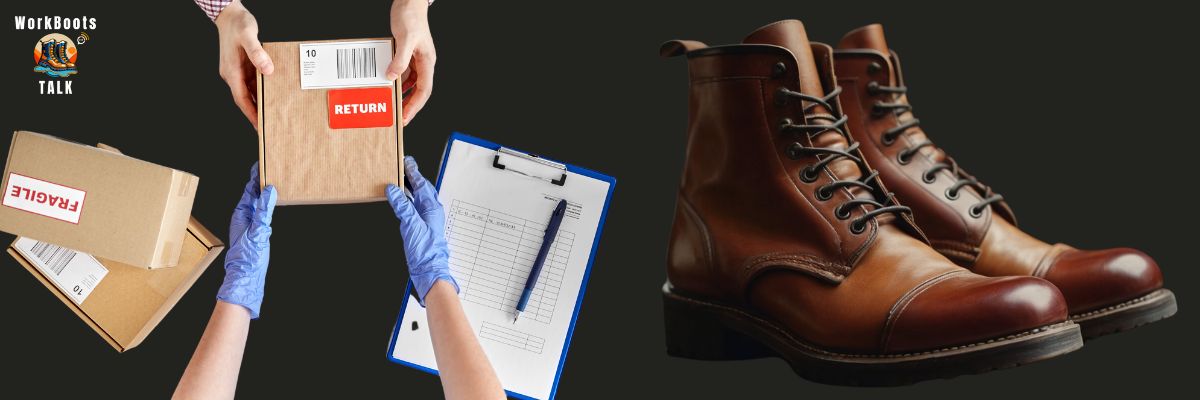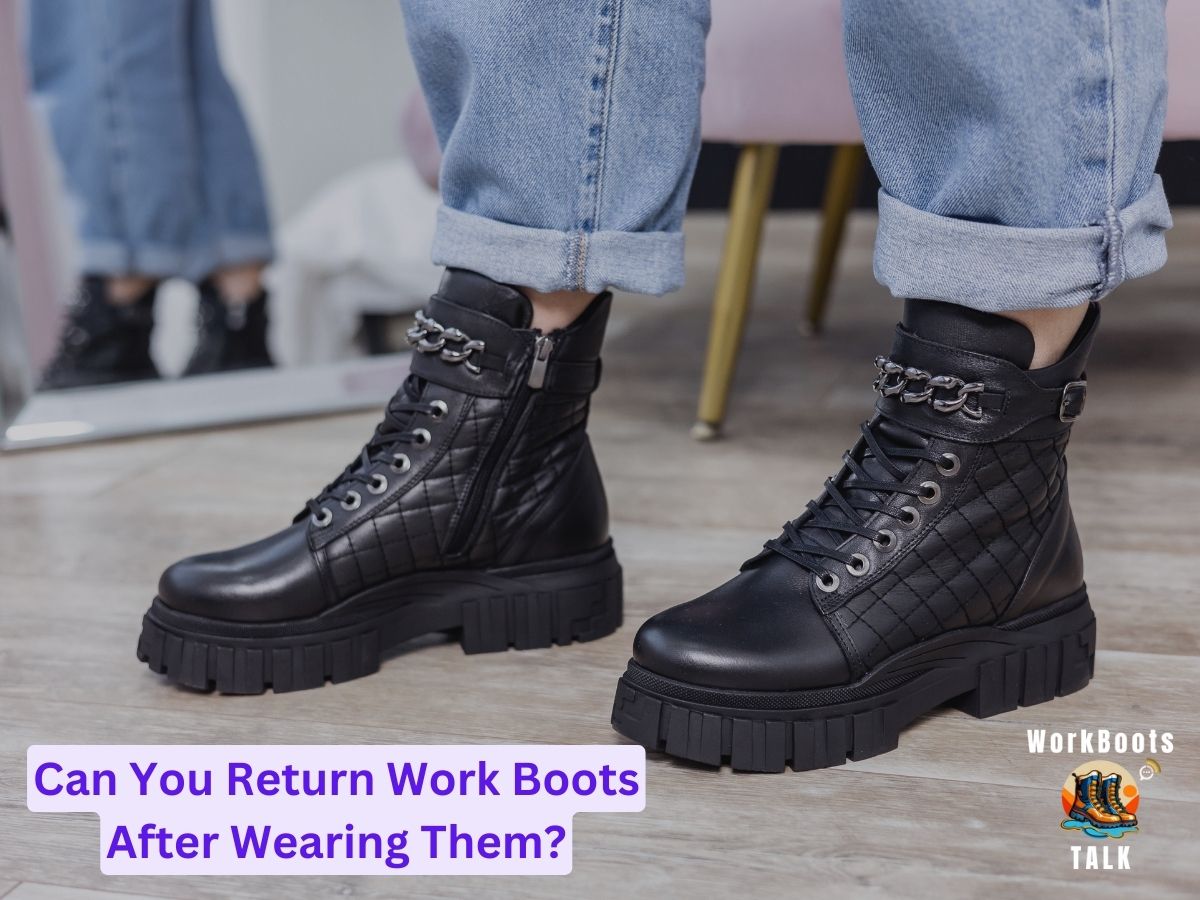Finding the ideal work boots is crucial for jobs demanding protection, durability, and comfort. Whether you’re on your feet all day or need sturdy footwear that can stand up to wear and tear, the timeframe for selecting the perfect pair is important. The challenge often lies in purchasing them either from online retailers or in-store without a prior fit test. What happens if, after a few days of use, the boots turn out to be uncomfortable, cause blisters around the toe box, or are defective? Is it possible to return them for a refund or an exchange?
The possibility of returning worn work boots largely depends on the retailer’s return policy, the warranty offered by the manufacturer, and the boots’ condition. This article aims to delve into these determinants, offering guidance and tips on navigating the return process for work boots. We’ll examine the advantages and disadvantages of making such returns, alongside alternatives if the boots don’t meet your expectations.
No matter where you’ve made your purchase – whether it’s an online retailer like Zappos or a physical store such as Walmart or Adidas, our insights will empower you to understand your customer rights and how to effectively exercise them. Before undertaking a web search to begin your query for the optimal pair, continue reading to learn whether you can return your worn work boots and the steps to do so.
Understanding Retailers’ Return Policies
Before you consider returning your worn work boots, the first step is to familiarize yourself with the retailer’s return policy. Each retailer may have its unique approach to returns, exchanges, refunds, and warranties—with some being more accommodating and others more restrictive.
General Return Policy Trends
Typically, most retailers will offer a return window, often ranging from 30 to 90 days after your purchase date. However, it’s worth noting that the return timeframe can vary widely, with some online stores offering shorter or longer periods, and a few not accepting returns at all. For instance, an online retailer like WorkBoots.com provides a 90-day return period, contrasted by Boots UK, which allows up to 35 days. For the most current and precise details, it’s advisable to perform a web search and visit the retailer’s website or reach out to their customer service.
Special Considerations for Work Boots
Given that work boots are designed for specific functions, including industry-specific features like steel toes or water resistance, their return policies may include additional stipulations. Retailers might request original packaging, proof of purchase, or tags to accept a return. As an example, WorkBoots.com insists on using something other than the shoe box as packaging for returns.
Restocking Fees and Condition Requirements
The condition of the work boots at the time of return, reflecting any wear and tear, is another important consideration. Returns for worn, damaged, or modified footwear may not be accepted by some retailers, or they might accept them with a restocking fee or a deduction from your refund. Specifically, the outsole and toe box should be inspected for excessive wear. WorkBoots.com, for example, charges $5.90 for a traceable, insured UPS label, which is waived if you choose store credit. Furthermore, specific condition requirements might apply depending on the item type. Boots UK, for instance, won’t accept returns for items that have been altered or show signs of significant wear and tear—unless they’re defective.
Examining Warranty Options
Before returning your worn work boots, it’s crucial to review the warranty options available. Warranties serve as a promise from either the manufacturer or retailer that your product will function as anticipated or it will be fixed or replaced if found defective. The scope of these warranties can differ greatly, encompassing duration, coverage, and specific conditions. Some warranties offer broader, more inclusive protection, while others may enforce more narrow, stringent limitations.
Manufacturer Warranties vs. Retail Warranties
When purchasing work boots, you’ll encounter two primary types of warranties: manufacturer warranties and retail warranties. Manufacturer warranties come directly from the brand or company that produced the work boots, such as Timberland, Georgia Boot, or Red Wing. On the other hand, retail warranties are provided by the store or website selling the product, like WorkBoots.com, Boots UK, or Merrell.
There can be significant differences between manufacturer and retail warranties, including their duration, claims process, and coverage scope. For instance, Red Wing might offer a lifetime warranty on its Heritage boot collection, whereas WorkBoots.com might only provide a one-year limited warranty on purchases. It’s important to thoroughly examine both the manufacturer’s and retailer’s warranty terms before making or returning a purchase, as their conditions and benefits may vary.
What Warranties Typically Cover
Warranties generally protect against defects in materials and workmanship which could impact the functionality or aesthetics of your work boots. If the boot’s sole breaks, splits, or comes apart, or if the leather shows tears, rips, or discoloration, you’re likely eligible for a warranty claim to have them repaired or replaced.
However, wear from regular use, accidental damage, misuse, or exposure of the footwear to conditions beyond normal wear and tear typically aren’t covered under warranty. For instance, spills from chemicals that compromise the health & safety of the footwear aren’t likely covered. To ensure your warranty remains valid, it’s essential to carefully read the warranty documentation and adhere to the recommended care and maintenance guidelines for your work boots.

Best Practices for Returning Worn Work Boots
- Deciding to return your worn work boots requires a thoughtful approach to ensure the process goes smoothly.
- Adhering to several key practices, such as preparing the necessary paperwork, taking care of your boots before returning them, and effectively communicating with the retailer or manufacturer can enhance your chances of a successful exchange or full refund.
- Plus, it helps you avoid unnecessary fees, keeps the return process hassle-free, and fosters a positive relationship with the seller.
Gathering Necessary Receipts and Documentation
- Begin the return process by collecting all necessary documents that verify your purchase and validate your return.
- This can include the original sales receipt, packing slip, return forms, warranty information, or any other documentation received with your purchase.
- Additionally, it’s wise to check the retailer’s return policy on their website or by contacting customer service to understand any specific steps required, such as filling out an online form, printing a return label, or explaining the reason for the return.
- Having your documents in order can expedite the process and minimize potential disputes or delays.
Caring for Boots Prior to Return
- Before returning your boots, it’s important to prepare them appropriately. This involves cleaning them thoroughly; even cobblers would agree that presenting your footwear in the best possible condition can facilitate the return process.
- Be sure to wear socks when trying new boots to minimize interior wear and to consider human factors, such as the fit around the foot and toe box, when assessing them for any wearable damage.
- Pack the boots in their original shoe box or one of a similar size to ensure they’re well-protected during the return. Don’t forget to include any accessories like laces or insoles.
- Properly preparing your boots not only shows respect towards the seller but also increases the likelihood of a favorable return outcome.
Communicating with the Retailer or Manufacturer
- The final step involves clear and courteous communication with the retailer or manufacturer. Reach out to them to explain your situation and request authorization for the return.
- Be polite and professional, supplying all necessary information like your order number and the reason for the return, along with how you wish to resolve the issue.
- Keeping a record of your interactions, including emails, phone conversations, or chat logs, can be invaluable if any disputes arise.
- Effective communication establishes trust and can smoothly resolve any concerns or questions regarding your return.
Tips for Keeping Boots Returnable
Ensuring your boots remain returnable involves a few simple steps. Let’s explore practical tips to maintain return eligibility:
A. Test Them Indoors First
Before venturing outdoors, consider the importance of indoor testing:
- Importance of indoor testing: Trying on and walking in your boots indoors allows you to assess their fit and comfort without risking damage. This ensures that if the boots don’t meet your expectations, they remain eligible for return.
- Ensuring return eligibility: By limiting outdoor use during the testing phase, you safeguard the boots’ condition, making it easier to return them if needed.
B. Preserve Packaging and Documentation
Protect the essentials required for returns by preserving packaging and documentation:
- Safeguarding return essentials: Keep all documents, including receipts and order confirmations, in a safe place. These are crucial for proving your purchase and initiating a return.
- Keeping packaging intact: Preserve the original packaging as much as possible. Some stores require items to be returned in their original packaging, and maintaining it ensures a smoother return process.
C. Regular Maintenance Tips
Extend the lifespan of your boots with regular maintenance:
- Prolonging boot lifespan: Clean and care for your boots regularly. This not only preserves their appearance but also contributes to their longevity, reducing the likelihood of issues that might lead to returns.
- Preventing wear and tear: Address minor issues promptly, such as loose stitching or scuffs. Regular maintenance prevents wear and tear, maintaining the boots in a returnable condition.
By following these tips, you increase the chances of keeping your boots returnable.
Conclusion
In this guide, we’ve delved into the topic of returning work boots after they’ve been worn. It turns out that the possibility depends on a variety of factors including the retailer’s return policy, the manufacturer’s warranty, and the boots’ condition. We’ve also shared essential tips for a smooth return process, such as keeping your receipts, caring for the boots before return, and communicating effectively with the seller. These strategies help ensure you get the most out of your purchase and sidestep potential troubles or disappointment.
Unsatisfied with your work boots? If they’re causing discomfort, perhaps pinching your feet or exacerbating health & safety concerns, you have the option to return them for a refund or exchange. But, before proceeding to contact your lender or reaching out to the online stores, it’s crucial to review the seller’s terms and conditions, as well as the product’s warranty. Also, ensure your boots are cleaned and properly packaged using the original shoe box, and reach out to the seller beforehand. By taking these steps, you’re setting the stage for a successful return, guaranteeing you reap the best value from your investment.
We hope you’ve found this piece both useful and enlightening. Should you have any inquiries or feedback, please don’t hesitate to get in touch. Your thoughts and needs regarding work boots matter to us, and we’re here to assist. Thank you for your time, and here’s to a positive shopping journey!
Frequently Asked Questions
1. Can you return shoes if they don’t fit?
Yes, most retailers accept returns for shoes that don’t fit. Check the store’s return policy for specific conditions.
2. Can I return the boots if I wore them?
It depends on the store’s policy. Some accept returns even if worn indoors, while others have restrictions. Review the return policy for clarity.
3. What is the return policy for the work boot warehouse?
The return policy varies by the work boot warehouse. Check their official website or contact customer support for detailed information.
4. How long do you have to return the boots?
Return windows vary by store. Usually, the timeframe falls between 15 and 30 days. Refer to the specific store’s return policy for the accurate timeframe.
5. What to do with shoes that no longer fit?
Consider alternatives like reselling or donating. Some stores may also accept returns within their specified conditions.
6. Do boots accept returns without a receipt?
It depends on the store. Some may accept returns without a receipt, while others require proof of purchase. Check the specific store’s policy.
7. Can I return the boots if they have been worn?
Policies differ. Some stores accept returns for worn boots; others may have restrictions. Review the store’s return policy for clarity.
8. What if the boots are damaged after wearing them?
Some stores may accept returns for defective items, including damage after wearing. Refer to the store’s return policy for guidance.
9. Are there any hidden fees associated with returns?
Check the return policy for information on potential fees. Some stores may charge restocking fees or shipping costs.
10. How long does the return process usually take?
The return process duration varies. It typically takes 1-2 weeks for the refund to be processed once the returned item is received. Refer to the specific store’s policy for accurate timelines.

